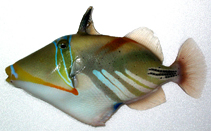| Family: |
Balistidae (Triggerfishes) |
| Max. size: |
30 cm TL (male/unsexed) |
| Environment: |
reef-associated; marine; depth range 0 - 50 m |
| Distribution: |
Indo-Pacific: East Africa eastward through northern Australia to Hawaiian, Marquesas and Tuamotu islands, north to southern Japan. |
| Diagnosis: |
Dorsal spines (total): 3-3; Dorsal soft rays (total): 23-26; Anal spines: 0-0; Anal soft rays: 21-23. Description: Characterized by generally whitish body color with yellow band from snout intersecting with dark bar through eye; dark brown area on middle of body connected to diagonal dark bands above anal fin; caudal fin base with rows of black dots; front of eye with deep groove; nearly straight dorsal and ventral head profiles; small, anterior projecting spines on caudal peduncle and adjacent posterior body in three horizontal rows; rounded caudal fin (Ref. 90102). |
| Biology: |
Commonly found in subtidal reef flats and shallow protected lagoons, Ref. 48637. Benthopelagic (Ref. 58302). Juveniles secretive with rubble patches, adults swim about openly but are usually shy (Ref. 48637). Territorial. Feed on algae, detritus, mollusks, crustaceans, worms, sea urchins, fishes, corals, tunicates, forams, and eggs (Ref. 3921). Oviparous (Ref. 205). Sleep on its side; makes a whirring noise when alarmed (Ref. 4420). Also caught with drive-in nets and is considered a popular aquarium fish (Ref. 9770). |
| IUCN Red List Status: |
Least Concern (LC); Date assessed: 14 January 2022 Ref. (130435)
|
| Threat to humans: |
reports of ciguatera poisoning |
Source and more info: www.fishbase.org. For personal, classroom, and other internal use only. Not for publication.

